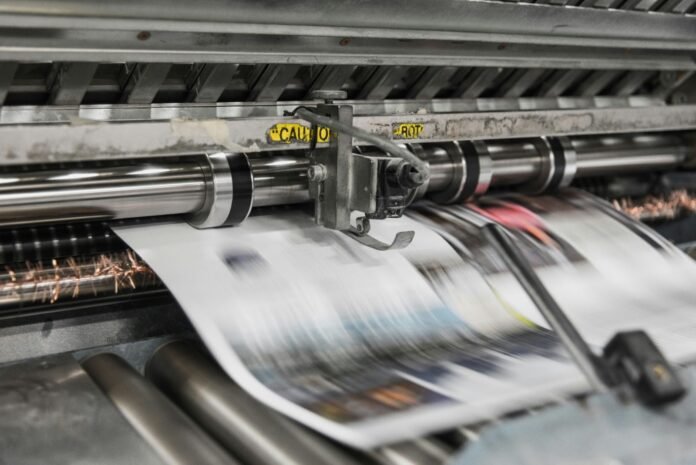Last Updated on January 31, 2024 by Asfa Rasheed
Photo by Bank Phrom on Unsplash
Welcome to the world of print finishing where craftsmanship meets innovation and ordinary transforms into extraordinary. In the article “Refining Impressions: The Evolution of High-Quality Print Finishing,” we explore the incredible journey of print finishing, highlighting its remarkable growth and the techniques that have made it an essential component of the printing industry. With a focus on the UK market, we explore the relentless pursuit of perfection and its lasting impact on the production of aesthetically pleasing and visually captivating printed materials. Whether you are a print enthusiast, a design professional, or simply intrigued by the intricate processes behind impeccable print finishing, join us on this enlightening journey of discovery and appreciation for the artistry within the realm of high-quality print finishing.
Table of Contents
Elevating Craft with Advanced Printing Equipment
This article aims to shed light on the lasting impact of certain techniques and how they have revolutionised the production of visually stunning and aesthetically pleasing final products.
In this exploration of print finishing, we witness the transformative power of advanced printing equipment and its ability to elevate craftsmanship. Through the seamless integration of traditional skills and technological advancements, print finishing can surpass ordinary expectations and deliver extraordinary results. Intricate details and elaborate designs, once considered impossible or prohibitively costly, can now be realised with precision and efficiency. This evolution has created boundless opportunities for businesses and individuals alike, enabling them to unleash their creative visions and achieve stunning visual outcomes with ease and sophistication.
Precision Meets Productivity
In print finishing, precision and productivity go hand in hand. This fascinating field combines craftsmanship’s artistry with modern technology’s innovation, creating extraordinary results from the ordinary. Every detail, from the choice of paper to the seamless binding and finishing techniques, contributes to the final product’s overall aesthetic appeal and visual impact.
Over the years, print finishing has undergone a remarkable evolution, driven by the relentless pursuit of perfection. The techniques employed in this process have become increasingly sophisticated, resulting in higher quality and more visually appealing prints. The UK market, in particular, has been at the forefront of this transformation, continually pushing the boundaries of what is possible.
The lasting impact of precision in print finishing is evident in producing visually stunning materials that captivate and engage audiences. Through the combination of traditional craftsmanship and cutting-edge technology, the printing industry has created products that not only meet but exceed expectations. The integration of precision and productivity has revolutionised how printed materials are perceived, opening up new possibilities for creative expression and marketing strategies.
The transformative journey that print finishing has undertaken, highlights its remarkable evolution and the techniques that have made it an indispensable part of the printing industry. With a focus on the UK market, the article illustrates the relentless pursuit of perfection and its lasting impact on the production of aesthetically pleasing and visually captivating materials. The melding of craftsmanship and innovation has resulted in a new standard of excellence in print finishing, where precision meets productivity.
Sustainability in Finishing
Sustainability in finishing has become an increasingly important aspect of the print industry. As more companies recognise the need to reduce environmental impact, print finishing processes have been adjusted to incorporate sustainable practices. This includes using eco-friendly materials, recycling waste, and implementing energy-efficient techniques.
One key area of sustainability in finishing is using environmentally friendly materials. Many traditional finishing techniques often require using non-recyclable materials, such as laminates and coatings. However, with advancements in technology, there are now sustainable alternatives available. For example, soy-based inks are replacing petroleum-based inks, reducing harmful emissions. Additionally, biodegradable and recyclable materials are being used for packaging, reducing waste and the carbon footprint.
Another aspect of sustainability in finishing is the recycling and reusing of materials. Rather than discarding waste, print finishing companies have implemented processes to recycle and reuse materials whenever possible. This reduces waste going to landfills, conserves resources, and reduces the need for raw materials. Furthermore, energy-efficient techniques, such as using LED lighting and implementing automated processes, help reduce energy consumption during finishing.
Overall, sustainability in finishing is an integral part of the print industry’s evolution. By incorporating eco-friendly materials, recycling waste, and implementing energy-efficient practices, print finishing companies are reducing their environmental impact and satisfying the growing demand for sustainable printing options. As technology continues to advance, it is expected that sustainability in finishing will become even more ingrained in the industry, further improving its ecological footprint.
















